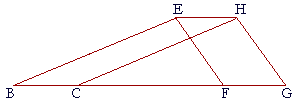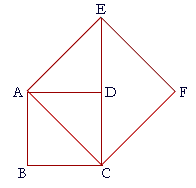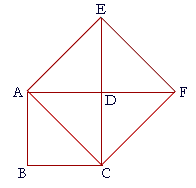Book I. Propositions 33 and 34Problems Back to Propositions 33, 34. 11. a) State the hypothesis of Proposition 33. To see the answer, pass your mouse over the colored area. Straight lines join the extremities on the same side of two equal and parallel straight lines. 12. b) State the conclusion. Those straight lines are themselves equal and parallel. 12. c) Practice Proposition 33. 12. State the definition of a "parallelogram." A parallelogram is a quadrilateral whose opposite sides are parallel. (Definition 14) 13. a) State the hypothesis of Proposition 34. A figure is a parallelogram. 13. b) State the conclusion. The opposite sides and angles are equal, and the diagonal bisects the area. 13. c) Practice Proposition 34. 14. The straight line ADE is parallel to the straight line BC, and AB is
Prove that AB is equal to DC, and angle EDC is equal to angle DAB.
Since AD is parallel to BC, and AB is parallel to DC, 15. By the distance from a point to a line, we mean the length of the 15. Prove that two parallel lines are everywhere the same distance apart.
Let the straight lines AB, CD be parallel, and let E and G be any two points on AB;
Draw EF and GH perpendicular to CD;
For, the straight line AB meets the two straight lines This could also be proved by showing that EG, FH are equal, and 16. Straight lines EH, BCG are parallel; EB and HC are straight lines;
Prove that EBCH is a parallelogram.
Since EFGH is a parallelogram, then EH is equal to FG; (I. 34) 17. Prove that a square is a certain kind of parallelogram. 18. A rhombus is a quadrilateral which is equilateral but not
Prove that a rhombus is a certain kind of parallelogram. 19. A rectangle is a quadrilateral in which all the angles are right angles.
Prove that a rectangle is a certain kind of parallelogram. 10. ABCD is a square; ACFE is a square drawn on the diagonal
10. a) Prove that ED is equal to DC, and is in a straight line with DC;
The diagonal AC bisects ABCD into two congruent and isosceles right triangles. (I. 34)
Next, side EA is equal to side AC;
10. b) Prove that the square drawn on the diagonal AC is twice
If we draw DF, then AF is also a diagonal of that square. This theorem asserts an essential knowledge of a square figure. Moreover, it led Pythagoras to realize that the diagonal and side are incommensurable. See Topic 10 of The Evolution of the Real Numbers. Table of Contents | Introduction | Home Please make a donation to keep TheMathPage online. Copyright © 2006-2007 Lawrence Spector Questions or comments? E-mail: themathpage@nyc.rr.com |






